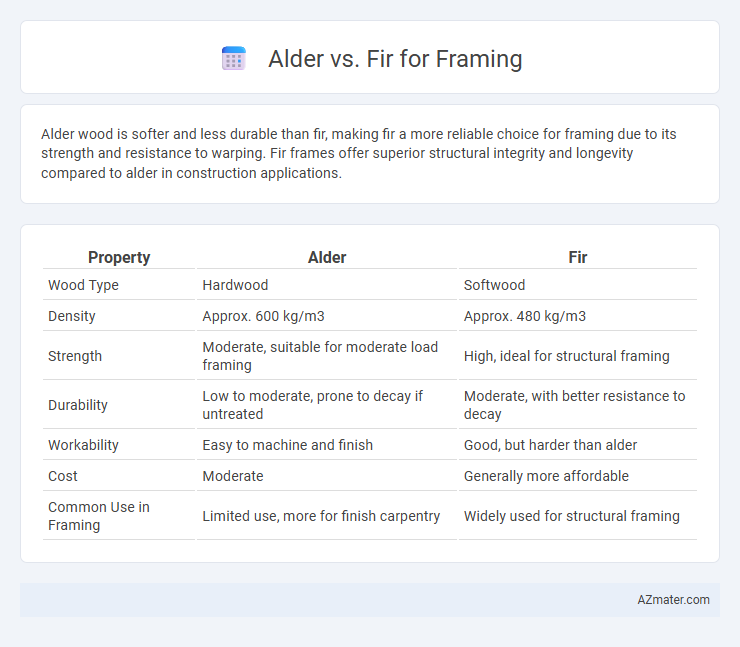Alder wood is softer and less durable than fir, making fir a more reliable choice for framing due to its strength and resistance to warping. Fir frames offer superior structural integrity and longevity compared to alder in construction applications.
Table of Comparison
| Property | Alder | Fir |
|---|---|---|
| Wood Type | Hardwood | Softwood |
| Density | Approx. 600 kg/m3 | Approx. 480 kg/m3 |
| Strength | Moderate, suitable for moderate load framing | High, ideal for structural framing |
| Durability | Low to moderate, prone to decay if untreated | Moderate, with better resistance to decay |
| Workability | Easy to machine and finish | Good, but harder than alder |
| Cost | Moderate | Generally more affordable |
| Common Use in Framing | Limited use, more for finish carpentry | Widely used for structural framing |
Introduction: Comparing Alder and Fir for Framing
Alder and fir are common choices for framing in construction, each offering distinct benefits based on wood properties. Fir is valued for its strength, durability, and straight grain, making it ideal for load-bearing structures and long spans. Alder is softer and lighter, often preferred for non-structural framing where workability and finish are priorities.
Wood Properties: Alder vs Fir
Alder wood offers a medium density with moderate strength and excellent workability, making it suitable for interior framing where ease of cutting and shaping is important. Fir, particularly Douglas Fir, provides higher strength, greater stiffness, and superior durability, which enhances structural integrity and load-bearing capacity in framing applications. Moisture resistance and natural stability in Fir wood contribute to its preference in outdoor or high-stress framing environments compared to Alder.
Strength and Durability Differences
Fir wood offers superior strength and durability for framing due to its dense, straight-grained structure, making it highly resistant to warping and splitting under heavy loads. Alder, being a softer hardwood, has lower strength and durability, which limits its use primarily to interior applications rather than structural framing. Construction projects requiring reliable load-bearing frameworks typically prefer fir over alder for enhanced structural integrity and longevity.
Workability and Ease of Use
Alder wood is softer and more pliable than fir, making it easier to cut, shape, and nail during framing projects. Fir, specifically Douglas Fir, is denser and stronger, providing superior structural support but requiring more effort and power tools for precise work. Both woods have good workability, but alder's lighter grain and smoother texture often reduce fatigue and speed up framing tasks, especially for less experienced builders.
Cost Comparison: Alder vs Fir
Fir is generally more cost-effective for framing due to its widespread availability and faster growth rate compared to Alder. Alder tends to be pricier because it is less common and has a slower growth cycle, which impacts its market supply. Choosing Fir over Alder for framing projects can significantly reduce material expenses without compromising structural integrity.
Availability and Sourcing
Fir is widely preferred for framing due to its abundant availability and consistent supply from North American forests, making it a cost-effective choice. Alder, being less common and primarily sourced from Pacific Northwest regions, can present challenges in large-scale procurement and may incur higher costs. Sourcing fir typically ensures faster delivery times and steady stock levels, essential for meeting construction deadlines.
Environmental Sustainability Factors
Fir offers superior environmental sustainability for framing compared to alder due to its faster growth rate and higher carbon sequestration capacity, making it a more renewable resource. Alder's slower maturation and lower density result in increased land use and longer harvest cycles, impacting forest regeneration negatively. Choosing fir supports responsible forestry management practices, reducing ecological footprints and enhancing long-term carbon storage in construction projects.
Common Applications in Framing
Fir is widely favored in framing for its strength, straight grain, and resistance to warping, making it ideal in structural applications such as wall studs, joists, and rafters. Alder, while softer and less durable, is occasionally used in non-load-bearing framing elements or interior trim where aesthetics and ease of machining are more critical than structural integrity. Fir's availability and affordability also make it a practical choice in residential and commercial framing projects.
Moisture Resistance and Stability
Fir offers superior moisture resistance and dimensional stability compared to alder, making it a preferred choice for framing in environments prone to humidity. Alder tends to absorb more moisture, which can lead to swelling and warping over time, reducing structural integrity. Fir's tighter grain and natural resin content enhance its durability and maintain frame alignment under fluctuating moisture conditions.
Final Recommendation: Choosing Between Alder and Fir
Selecting between alder and fir for framing hinges on balancing durability and workability; fir offers superior strength and resistance to warping, making it ideal for structural integrity. Alder, while softer and easier to shape, suits non-load-bearing applications where aesthetic appeal and finish are priorities. For long-term framing projects requiring robust performance, fir remains the preferred choice.

Infographic: Alder vs Fir for Framing
 azmater.com
azmater.com